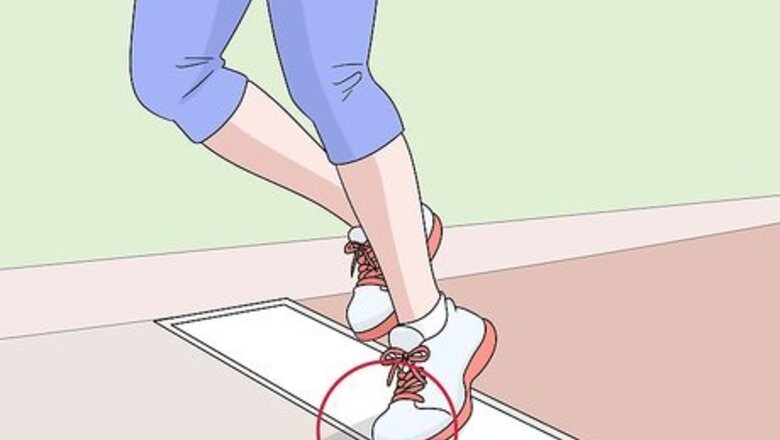
views
Common Mistakes
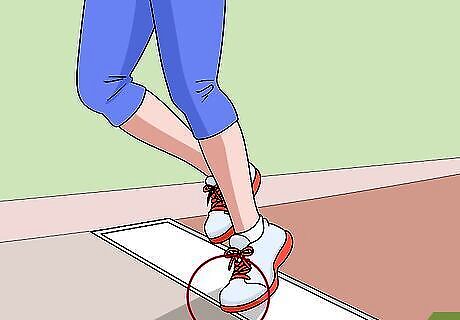
Jump with your toes as close to the edge of the board as possible. To maximize your distance, jump with your foot as close to the end of the board as possible. The width of the board is typically 8 inches (0.20 m), and it is legal to jump from any point on this board. This means that a 6 ft (1.8 m) jump from the back of the board would score a full 8 inches (20 cm) farther from the front of the board. That’s a big boost! If you go over the line, your jump is a foul. In most events, you will have 2 more attempts to perform a legal jump. This is particularly important if the board that you’re using is wider than 8 inches (20 cm), since some of your opponents may jump from much further back.

Keep your head up when you launch from the board to avoid losing momentum. The tricky part of initiating a jump is that you lose speed if you look down, so keep your head upright and keep the board in your peripheral vision. When planting your foot to take off, keep your eyes on the sand pit in front of you and trust that your foot is planted legally the board. The more jumps that you make, the better you will become at keeping your head up and jumping from a powerful position. It is extremely tempting to look down while you throw your body up into the air. The more you practice jumping, the more you’ll get used to staying upright when you launch.

Aim to jump at a 22-degree angle to maximize your flight distance. If the human body were a perfectly round ball, you’d want to jump at a 45-degree angle for a perfect arc. Unfortunately, you aren’t that aerodynamic. Due to the shape of the human body, the optimal take-off angle is around 22 degrees. This is pretty low to the ground. With each jump, aim to propel yourself forward, not straight up. Since you’re in motion and there are rarely reference points to judge your angle, it’s extremely hard to determine what 22 degrees looks like. This comes down more to feel than anything else. At your maximum height, your feet should be roughly where your hips are when you’re standing on the ground. If you can, have someone film you from the side at a competition. This way you can review the footage and determine if you’re jumping too high or too low.
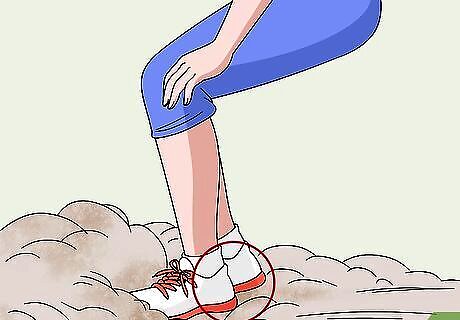
Land on your heels and keep your hands and back off of the sand. As your feet slide into the sand, do everything in your power to avoid dropping your hands or butt into the sand behind you. Your jump is scored based on the first break in the sand, not where your feet hit, so if you lean back into the sand you’re actively subtracting from your distance. When landing, do not try to break your fall. The sand will protect you from injury and cushion you as you roll forward.Tip: This is one of the hardest parts of the long jump, especially for younger athletes. The impulse is almost always to try and break your fall or land straight up. You’re always going to do better if you simply let yourself roll forward, though. If you watch the professionals, they don’t always look pretty when they land! They often roll forward ungracefully into the sand. This is because the only important part of landing is not falling back, but rolling forward.
Performance-Boosting Drills

Practice your running and sprinting form to improve your speed. Take regular 10-15 minute jogs several times a week and do 10-15 wind sprints in between jogging sessions to develop your approach. When running, focus on maintaining a straight spine, keeping your eyes forward, and driving your arms up to your chin while moving the opposite knee up. If you can develop a strong running form, the rest of the long jump will become much easier. A wind sprint is when you walk, run slowly, then sprint before repeating the cycle again.
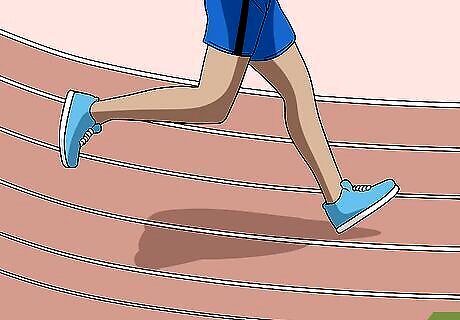
Do run-run-bound drills to practice getting close to the edge of the board. Go to an indoor or outdoor running track. Over the course of 100 ft (30 m), practice the launching process by running 2 steps and jumping forward with the proper form. Focus on keeping your head under your body and your spine straight. Repeat this for the remainder of the 100 ft (30 m) to practice your footing and jump sequence. You are not launching yourself hard into the air while doing this. Each jump should look like a small skip. Focus on the form, not the speed.
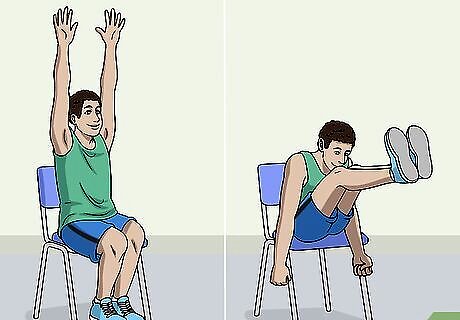
Practice the landing form while sitting in a chair to get used to it. The mid-air movement where you drive your arms down and extend your legs out can feel incredibly awkward if you’re new to long jumping. To get used to this motion, sit in a folding chair with your spine and legs at a 90-degree angle. Then, raise your arms up and practice driving your legs out in front of you. At the same time, drive your arms down in front of your knees and spread them out behind you. Practice doing this as quickly as possible to get used to the landing sequence. This is a phenomenal drill if you’re newer to long jumping and struggle with the landing. You can do this in the sand if you want to practice landing with your heels at the same time.
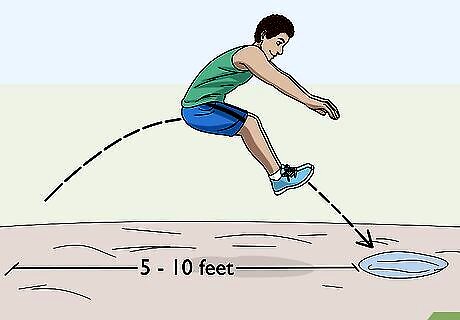
Work on driving your heels through a spot in the sand to get used to landing. To get used to the feeling of landing, dig a small hole into the sand. Then, 5–10 feet (1.5–3.0 m) from the pit, jump like you normally would at a long jump event without the long approach. Practice landing right in the hole and driving your heels through the sand without falling back. The more you get used to this feeling, the more likely you’ll be to land correctly in a competition.Tip: Don’t do too many of these in one training session. Roughly 10-15 reps should be fine, but doing a lot of jumps in one session can be bad for the knees. If the sand in front of the hole doesn’t break, you know that you’re landing correctly.
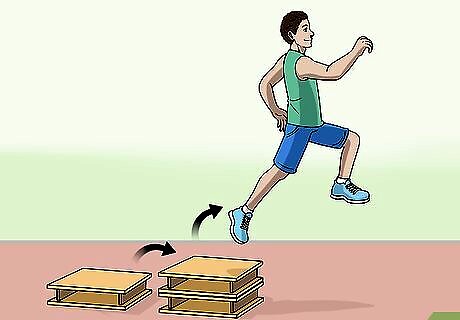
Perform the 2-box drill to practice driving your knee. Put a stable 6–12 in (15–30 cm) box roughly 8 ft (2.4 m) before the board. Stack 2 identical boxes on top of one another roughly 4 feet (1.2 m) before the board. Step back 15 feet (4.6 m) from the boxes and do a normal approach at half speed. Climb up the boxes on approach and launch from the second set of boxes. Do this 10-15 times per practice session to improve your knee drive and practice your form in the air. The boxes serve 2 functions. First, they force you to drive your knees harder before jumping since you have to clear the higher steps. A strong knee drive contributes to a longer jump. Second, they give you more time in the air since you’re jumping from higher off of the ground. This makes it easier to practice your form in the air. This is a more advanced drill. It is not a good way to practice for a newer jumper since the boxes can make the approach feel more complicated than it is.
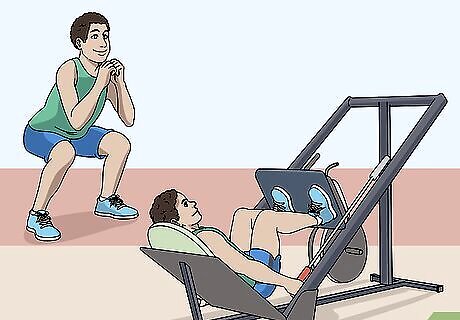
Do squats and leg presses to build muscle and increase performance. Long jumping requires a lot of leg strength. To develop your legs, work with a partner or trainer in the gym to do some weight training. Barbell squats, leg extensions, and leg presses are all excellent weight-resistant exercises for long jumping. Keep in mind, you need to be limber to jump, so focus on doing a high number of repetitions with a lower weight. Always stretch thoroughly before and after weight training. Calisthenic exercises like lunges, squats, and yoga are also great for long jumpers.
Proper Form
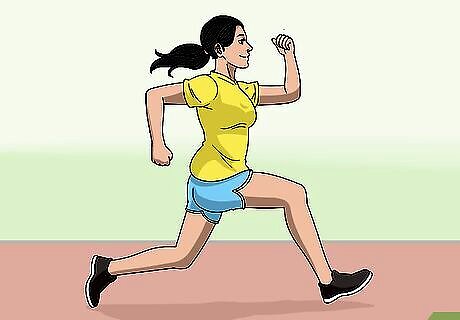
Approach your jump with a good jogging form and sprint. Start roughly 100 feet (30 m) from the board, which is the strip where you jump off into the sand. Begin approaching with a light jog and focus on pumping your arms and legs in an even rhythm. Then, break into a hard spring once you’re 50–75 feet (15–23 m) from the board. Sprint with your arms pumping, head over your spine, and eyes forward to approach the board. Keep your spine upright with your legs and arms pumping forward in 90-degree angles at opposite intervals to maintain a good running form. For example, as you lower your left arm, your right leg should be driving forward and vice versa. You may see professional long jumpers doing strange jumping or hopping exercises before they begin their approach. These are just personal rituals or warm-up exercises; they don’t have anything to do with the mechanics of the approach. Your long jump distance is severely limited if you aren’t using a proper jumping form.
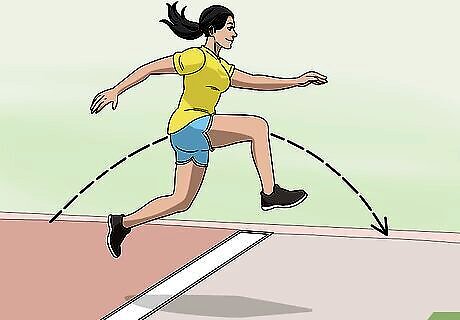
Initiate the jump on the board with your leg planted underneath you. The board is the strip of paint, tape, or wood in front of the sandbox. You must jump with your foot on this board, without crossing it. When you’re 5–10 feet (1.5–3.0 m) from the board, prepare your dominant leg to land in the center of the board. As your foot lands on the board, push off from your dominant foot as soon as your back lines up over your leg.Tip: Avoid planting your jumping foot in front of you. Many amateur long jumpers will do this because it feels more stable, but this will slow you down dramatically. Let your foot land naturally underneath you on the board and jump with your momentum intact to maximize your distance. This looks like you’re standing up straight on one leg when you push off of the ground. Some long jumpers prefer launching with their nondominant leg. Either leg is fine, but don’t go back and forth between legs for your launch.
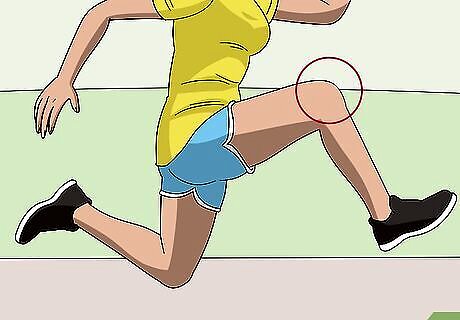
Drive your knee forward while pushing off of the ground. While you’re pushing off with your dominant leg, drive your nondominant knee up like you’re trying to touch your knee to your chest. At the same time, drive your dominant arm forward with your elbow bent at a 90-degree angle. Your leg and arm must move at the exact same time to keep your body balanced as the momentum pushes you forward.
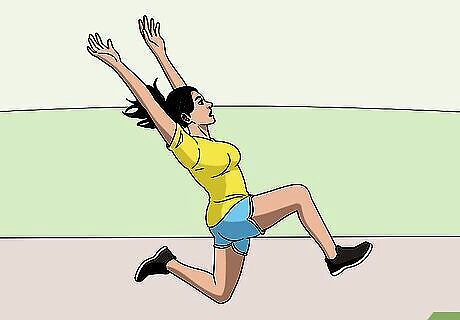
Swap your knee positions in midair and raise your arms up. As you fly through the air, swing your dominant knee forward while pulling your nondominant leg down and back like you’re running in the air. After pumping your arms once, raise your arms up above you as you cross the apex of your jump. This will make it easier to drive your legs forward and increase your distance.
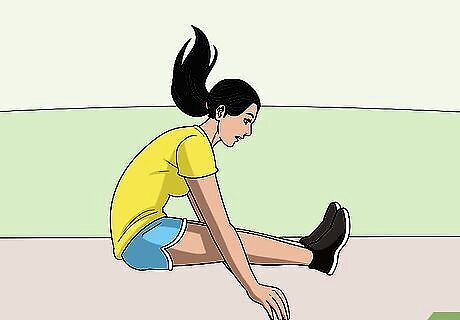
Extend your legs forward while tucking your arms down to land. During the final third of your jump, throw your arms down in front of you. At the same time, straighten your legs out and pull them up in front of you. Land with your heels in the sand first and let your body roll or fall forward. Do not reach back to brace your fall, since this is more likely to harm your distance. Allow your body to tumble into the sand. Don’t try to stop yourself or land standing on your feet. Bend your knees forward as you land. It’s perfectly alright if you start falling to the right or the left as your knees bend.



















Comments
0 comment